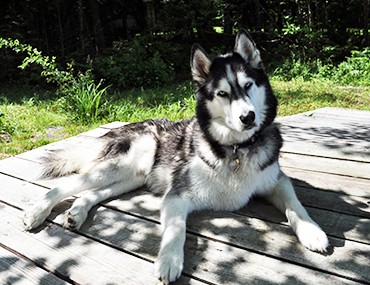Background
The perfect sled dog!
The Siberian Husky was used for centuries and centuries to pull the sleds of the Chukchi Tribe on the eastern Siberian peninsula. Huskies were also used for herding reindeer and guarding. Perfectly adapted to the brutal Siberian weather, the Husky is a hardy, thick-coated dog with legendary stamina; he was so prized for his speed that he was brought to Alaska by fur traders for sled dog races.
First used for the 1908 All-Alaskan Sweepstakes race – a 408-mile dogsled competition – Huskies were later prized during a diphtheria epidemic in Nome, Alaska because they proved an invaluable form of transportation for medicine to the sick. Huskies have also been used as search-and-rescue dogs as well. Today, the Husky is one of the most popular dogs in America.
Sizing Up
The Husky is a medium-to-large-sized breed. Here are some common physical traits of the Husky:
- Weight: 35-60 lbs.
- Height: 21-23 inches (to the shoulders)
- Coat: Thick, medium-length double coat that can withstand temperatures as low as -75F
- Color: Black to pure white, black and white, red and white, brown, gray and white
- Lifespan: 12-15 years
What are they like?
Don’t let his wolfish appearance fool you. If you’re looking for a gentle, happy, friendly dog that is comfortable around other dogs and strangers, the Husky is all of the above. Because of centuries of running and tugging sleds across tundra, the Husky loves to run. And run. And run some more. Perfect for the active family, the Husky is as high-energy as he is easygoing.
The Husky is also extremely intelligent. This makes him highly trainable, but also easily bored and prone to getting into “trouble” sometimes – for example, it’s not uncommon for a Husky to open a refrigerator and eat the food inside. And believe it or not, the Husky is pretty easy to groom. An occasional brush will do the trick when he’s not shedding. When he is, you’ll have to pay a little more attention to him.
The Siberian Husky is a tough, hardy breed with just a couple of notable hereditary issues:
- Bloat, which can lead to gastric dilatation volvulus
- Hip dysplasia
- Eye problems such as corneal dystrophy or juvenile cataracts
- Allergies
Right for you?
Siberian Husky puppies are pretty much irresistible! But, as with any new pet, there are some considerations to make before you welcome a Husky into your family:
- The Husky might dig up your yard or chase squirrels. As an excellent escape artist, he may dig his way under your fence and run into the night. He’s not doing it to make you mad – it’s just due to hundreds of years of unchecked instinct. But that’s why it’s extremely important to start training early and stick with it.
- Huskies need a lot of exercise because they have been bred for centuries for very strenuous tasks. Regular runs, walks, or hikes are great for a Husky, but this means they aren’t a great breed choice for sedentary people or families
- It should be pretty obvious, but the thick coat means that Huskies aren’t big fans of searing heat. Make sure to keep an eye on them during the summer months, and provide plenty of fresh water.
- The Husky sheds like crazy once or twice a year. You’ll have to be prepared for a blizzard of Husky fur.
When trained well and exercised thoroughly, the Siberian Husky can be a great companion for the right person or family. For more information about the breed, be sure to talk with your veterinarian.
If you have any questions or concerns, you should always visit or call your veterinarian – they are your best resource to ensure the health and well-being of your pets.
![]()
